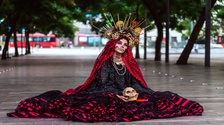Find English Teachers
john
ta1 shi4 yi1 ge4 gao1 de nan2 ren2. Here please explain "de"
Nov 17, 2011 6:14 PM
Answers · 21
4
"de" is kind of tricky. Mainly because it has many functions. I'll explain the best I can, though.
First, your sentence should be 他是一个很高的男人(ta shi yi ge HEN hao de nanren). In Chinese, an intensifier is always required. Try not to get confused with how in English we say "he is tall". In Mandarin, the "is" is omitted and instead an intensifier such as "hen" or "zhen" is used. "hen" is most often used, since it's like "is" and is rarely translated as "very"
The 的 doesn't have a meaning. It's another one of those "no meaning, but helps sentences function correctly" kind of words. (like "了" for example). It acts as a modifier which shows a relationship between two things. In a normal sentence where the adjective is placed after the noun, "de" is not needed: i.e. 他很高 = he [is] very tall. The adjective comes after the noun, so "de" is not needed. However, in sentences where the adjective is placed BEFORE the noun, "de" IS needed:
很高的人(hen gao de ren) = "Tall people" or "people who are tall". Or imagine a sentence like "THE nine o'clock movie" or "people WHO cannot speak French." Now remove "the" and "who" from those sentences. They wouldn't make sense. Although 'de' has no meaning, you can treat it like those words in those examples.
'de" also helps omit words. In other words, it chops sentences in half. Like in English when we say "the small one" as opposed to "the small cup of coffee". You can think of 'de' as the word that cuts words in half and makes them much simpler.
take the following scenario:
Example:
You: 我该穿哪件衣服呢?(wo gai chaun na/nei jian yi fu ne)- Which outfit should I wear?
Friend: 穿红色的衬衫吧!(chaun hong se de chen shan ba!) - wear the red blouse!
You: 太旧了,我穿过很多次 (tai jiu le, wo chuan guo hen duo ci) it's too old, i've worn it so many times.
Friend: 那么,白色的呢(na me, bai se de ne?)Well...how about the white one?
See how when "红色的衬衫"(red blouse) was introduced for the first time, "衬衫" was placed after "de"? When the friend refers to the white blouse, it was shortened to"白色的".
The tricky part is: when forming attributive sentences like these, they are the opposite of how we speak in English.
i.e. "People who are going to China" would be: 要去中国的人.
In Chinese, the sentence order is reversed: "going to China + "的" + people".
November 18, 2011
2
的 (de) is a particle, it´s not an adjective. 的 can be used as a possessive particle (wo de che= my car) or after an adjective to show that the noun that come after the adjective is being modified by this adjective (hongse de che= red car).
In chinese you can´t link directly a noun and an adjective, it´necessary this particle between them.
高 (gao) without the particle "de" is a verb (to be tall), "de" makes gao become an adjective.
ta shi yi ge gao de nanren= he is a tall man (here gao is an adjective modifying the noun "nanren")
ta hen gao= he is tall (here "gao" is a verb- "to be tall", so you don´t use the particle "de").
的 can also appear after an adjective in the "是 … 的" (shi....de) construction, like "wo de che shi hongse de= my car is red", but here "shi....de" is an expression also used in many other kinds of sentences without adjectives involved.
November 17, 2011
1
the 3 de words in Chinese grammar can be quite hard for non-chinese people to understand. In this case imagine you are asking the question "which one?" and answering "the one that is ..." So using your example - "which man?" "the one that is tall" So even though they aren't real adjectives, if you think of them a bit like a funny adjective it helps to get your head round it. For instance "I caught the 9.30 train to Beijing" I caught the 9.30 DE Beijing DE train. - which train? the 9.30 one. which train? the Beijing one. Do you know what I mean?
November 17, 2011
gao is an adjective, when the adjective is placed at the end of a sentence, we say "gao". For example, ta1 hen3 gao1." means "he is tall".("hen3" means "very").In this sentence gao1 has the same meaning and use of tall. But if the adjetive is placed before a noun, there should be a "de" between them. "de" is a grammatical word which is used to connect an adjective with a noun. adj.+de+n.(Chinese) has the same grammatical use of adj.+n.(English).
November 18, 2011
my=我的,
my book=我的书,
his=他的,
his knife=他的刀,
tall=高的,
tall man=高的男人,
your question=你的问题,
the character 的 usually be placed before a noun, after an adj ,verb or pron.
I dont think there is a word means the character 的, because English words and Chinese characters are not simple corresponding relationship。(后半句是百度翻译的,哈哈。)
的通常放在名词的前面,是定语的标志,而且它一般紧跟在形容词,动词或者代词的后面。其他用法对外国朋友来说,掌握起来有一定难度,这是最常见的用法,也是最重要的用法。
November 20, 2011
Show more
Still haven’t found your answers?
Write down your questions and let the native speakers help you!
john
Language Skills
Chinese (Mandarin), Telugu
Learning Language
Chinese (Mandarin)
Articles You May Also Like

🎃 October Traditions: Halloween, Holidays, and Learning Portuguese
7 likes · 0 Comments

The Curious World of Silent Letters in English
3 likes · 2 Comments

5 Polite Ways to Say “No” at Work
14 likes · 3 Comments
More articles
